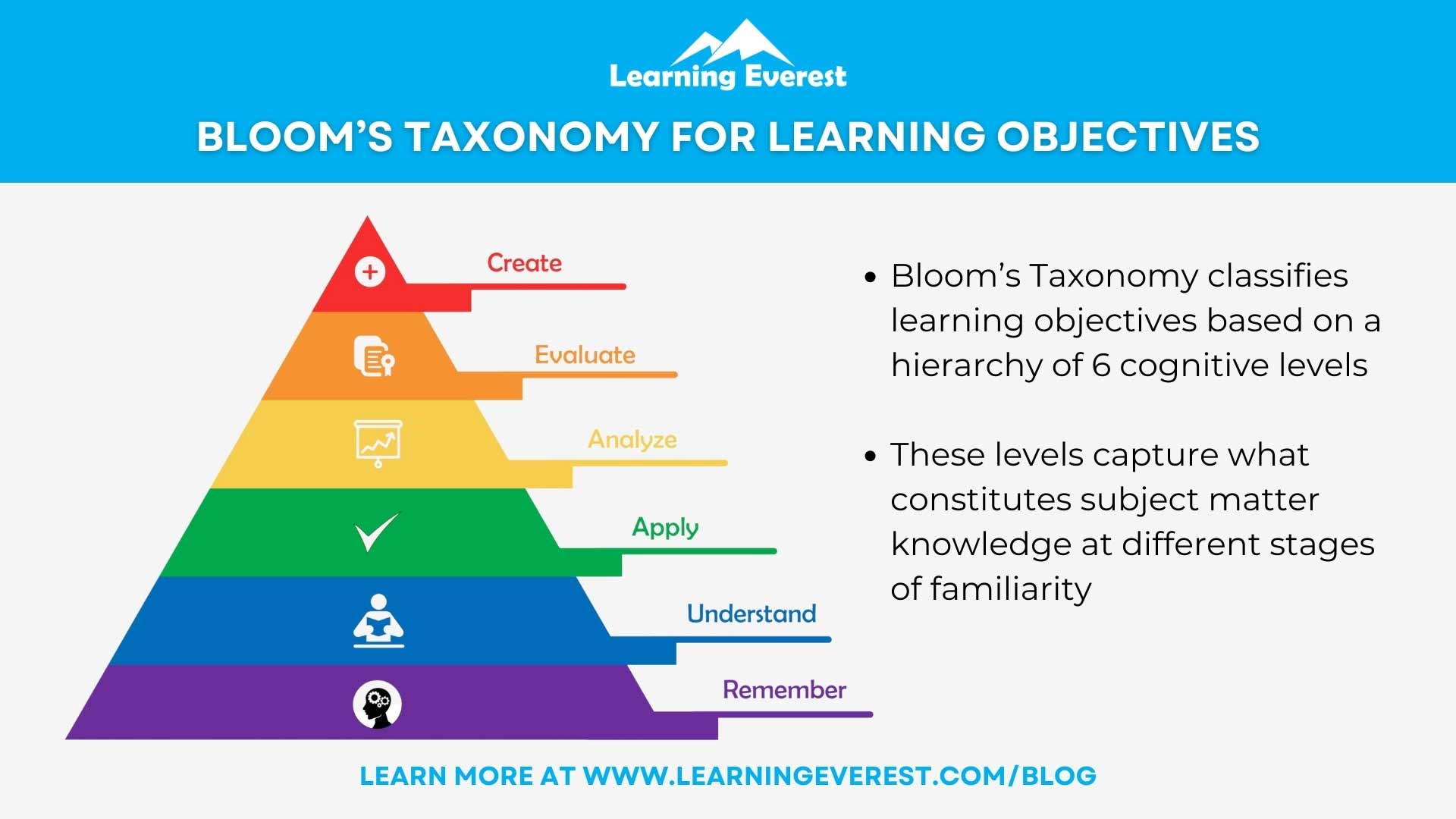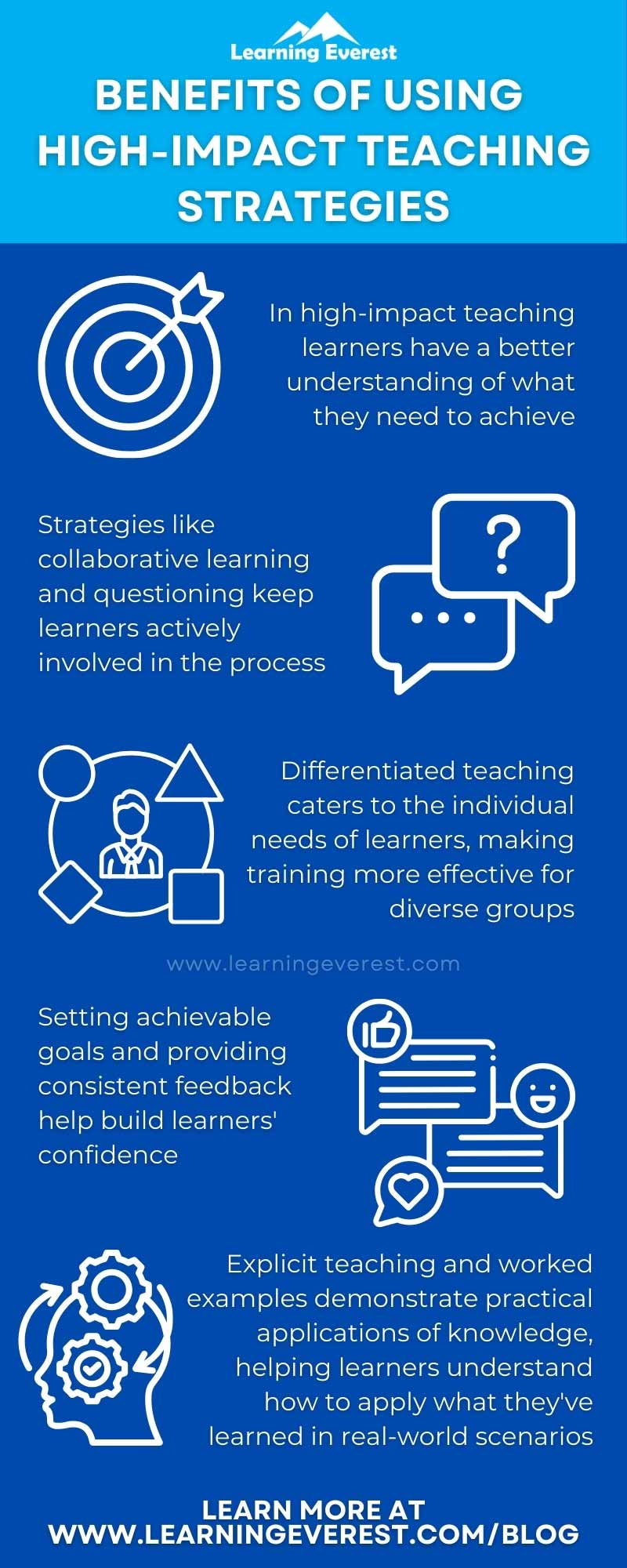High-impact teaching strategies are a collection of instructional practices that can be used to improve learning. If you are interested in high-impact teaching, this is for you. Let’s dive in!
Table of Contents
- ¿Cuáles son las estrategias de enseñanza de alto impacto?
- Infographic
- Knowledge check!
- Preguntas frecuentes (FAQ)
- P: ¿Qué son las estrategias de entrenamiento de alto impacto?
- P: ¿Qué es un ejemplo práctico de estrategias de enseñanza de alto impacto?
- P: ¿Cómo se puede utilizar la retroalimentación en estrategias de enseñanza de alto impacto?
What are the high-impact teaching strategies?
1 – Setting goals/objectives
Why are goals important? Think about how goals help you know what you need to achieve. All lessons should have clear goals/objectives, and these goals should be communicated to learners so they know what the desired outcome looks like. Using goals, high-impact instructors clearly explain what a learner needs to understand or be able to do at the end of the lesson. Setting goals not only helps learners understand what is required of them. But it also enables instructors to better plan their learning.
Goals should be meaningful and relevant to the learners, and should be designed to challenge their capabilities, while still being realistic and achievable. This means that different learners should have different goals. It is also important that teachers acknowledge and reward any effort learners make towards achieving their goals.

Bloom’s Taxonomy for Learning Objectives
Let us look at how to put Bloom’s taxonomy into practice to write compelling and purposeful objectives for corporate learning. Read our blog on How to write learning objectives using Bloom’s taxonomy.
2 – Structuring lessons
Structuring lessons involves taking a structured approach to creating lesson plans that are engaging and meaningful for learners. A lesson structure provides learning for different activities and includes a clear roadmap. Structuring lessons ensures activities are linked to learning objectives/goals, and that time is optimized. Lesson structures provide learners with transparent and predictable routines.
A well-structured learning plan begins with setting the purpose/objective of the lesson, articulating clear outcomes, and outlining the content to be covered. Transitions between learning modules should be smooth, but apparent. It is important to call attention to the main ideas throughout the lesson plan and to end the lesson with a conclusion of the main points.

High-impact teaching strategies for instructors : How to Structure a Lesson?
You can read our blog on Training Roadmap – An Amazing Transformational Journey For An Organization.
3 – Explicit instruction
Explicit instruction focuses on providing learners with clear, precise instructions and explanations about the core concepts and ideas being taught. In other words, showing learners what to do and how to do it. Explicit teaching also provides learners with opportunities to apply their skills/knowledge and demonstrate their understanding through practice. When practicing explicit teaching,
- set a clear goal,
- articulate the goal to learners, and then
- demonstrate how to achieve the goal, providing examples.
Learners should then be given an opportunity to practice what they have learned. At the end of the training lesson, revisit what the lesson has covered, check your learners’ understanding with questions and assessments, and provide constructive feedback and additional support where required.
4 – Case study
You can use case studies to demonstrate how to complete a task or job role or solve a high-end problem. This method allows learners to compare their own thinking and strategies with those of the experts, providing them with the opportunity to achieve insight into the thought process behind solving the problem.
Case studies demonstrate exactly what success looks like, and give a model of the problem-solving process that learners can refer to. Having this model decreases the cognitive load on learners, allowing the learners to focus on understanding the process required to complete a task. Learners can also use the worked example as a reference when practicing. When presenting a case study, each solution should be explained clearly. Case studies should also be differentiated based on the learner’s knowledge of the topic.

High-impact teaching strategies for instructors : What is a case study?
5 – Collaborative learning
Collaborative learning motivates learners to work together to learn new skills, providing an opportunity for practical use and collaboration with peers. This high-impact teaching strategy allows learners to build their knowledge/skills through the exchange of ideas while also encouraging problem-solving, critical thinking, communication, and teamwork. Collaborative learning can take many formats, such as
- small-group activities,
- social learning,
- learner-led discussions, or
- whole-group projects.
When developing group learning activities, make sure to incorporate team-building skills, such as negotiation and collaboration. To promote interaction, it is a good idea to select the members of each group based on the same interests, skillsets or academic abilities. It is also advised to assign roles to members of the group to encourage learners to take responsibility for jobs, and to design tasks so that learners can share information and expertise.
6 – Multiple exposures
Multiple exposures involve exposing learners to the same content multiple times. When learners are exposed to information multiple times, the information becomes more meaningful. Moreover, repeated exposure to material allows for increased understanding as learners build upon what they have already knew and gain new perspective into the topic.
The idea behind this strategy is to give learners continued exposure to topics or materials in different style, yet related ways. Instead of introducing a topic once and expecting learners to understand it, multiple exposures offer learning opportunities over an extended time period. When using multiple exposures, it is important to provide learners with feedback to ensure they don’t repeat the same mistakes multiple times.
7 – Questioning
Questioning is a powerful way for engaging and challenging learners. The practice of asking questions involves asking questions in order to prompt learners to think deeply and critically about a concept or topic. Questioning can also be used to elicit constructive feedback on whether a learning strategy is working. It prompts them to link various topics to their real life tasks, or encourages them to engage in meaningful conversation with other learners. By engaging in the practice of asking questions, instructors can help learners develop their problem-solving and critical thinking skills, also build upon prior knowledge.
Mainly, questions should be open-ended, allowing for learner exploration, as questions with only one probable answer can develop critical thinking. Questioning can be used to receive immediate feedback, check your learners’ understanding of a topic, and evaluate the effectiveness of your instructional strategies. For questioning to work, learners must feel safe to share – that means fostering a respectful learning environment, where learners are not judged for holding different views, and where learners feel safe to contribute.
Read out our blog on Exploring What is Formative Assessment.
8 – Feedback
Feedback can be used to check a learner’s understanding, evaluate the effectiveness of a training approach, and help with learning. While the ultimate goal of feedback is to improve learner learning, it is important that it flows both ways – from instructors to learners, and vice-versa.
Two-way feedback ensures that learners receive advice that can improve their performance, while instructors are made aware of how their teaching is impacting learners. Feedback should be detailed, structured and provide specific guidance on how to improve, and encourage more effort. Feedback should be focused on the lesson (rather than the person), and can be given by both the instructor and a learner’s peers.

High-impact teaching strategies for instructors : Choose Assessment Methods
Want to learn how understanding the role of feedback and mastering the art of feedback can transform the learning experience, read our blog on 5 Critical Role of Feedback in Improving Learning Experience.
9 – Metacognitive strategies
Metacognitive strategies help learners become more aware of their own learning process. They understand how to learn better, and make more effective decisions when it comes to learning. They also help other learners find motivation for learning. In other words, metacognitive strategies teach learners how to teach themselves. It enhances the effectiveness of all other teaching strategies. They also empower learners to learn outside the classroom. Metacognitive activities include helping learners set goals and self-monitor their own progress.
10 – Differentiated instructional approach
Differentiated teaching emphasizes customized learning and instruction. In this way, you design and deliver tailored training lessons that cater to the unique needs of each learner. Differentiated lessons should cater to different interests, learning styles, capabilities, and ways of thinking and learning. This allows your learners to acquire knowledge at their own pace, meaning that all learners are challenged and all learners achieve success, regardless of their academic ability or learning style.
Differentiated teaching also allows for accommodations for learners with special requirements, enabling them to obtain a learning equal to their peers. Lesson plans should allow for a differentiated learning approach, enabling you to adjust based on the needs of different learners. To enable differentiated learning, make sure to regularly assess your learners to monitor learners progress and recognize if and where extra support is needed.
Do you like to add anything? Comment us below!
Infographic
Knowledge check!
Frequently Asked Questions (FAQs)
Q: What are high-impact training strategies?
A: High-impact teaching strategies are a collection of instructional practices that can be used to improve learning.
Q: What is a worked example in high-impact teaching strategies?
A: A worked example is basically a case study that gives a model of the problem-solving process to which learners can refer.
Q: How can feedback be used in high-impact teaching strategies?
A: Feedback can be used to check a learner’s understanding, evaluate the effectiveness of a training approach, and help with learning.






